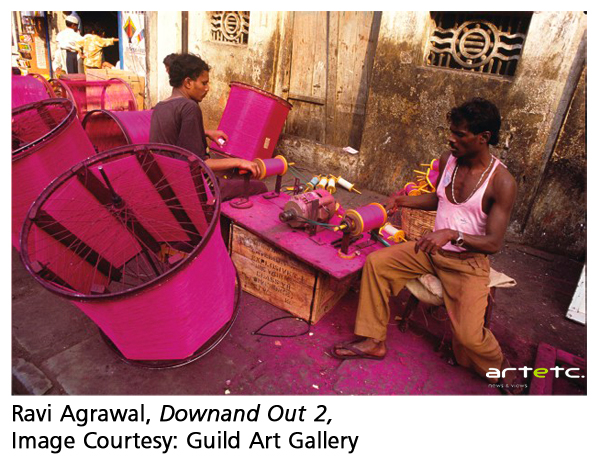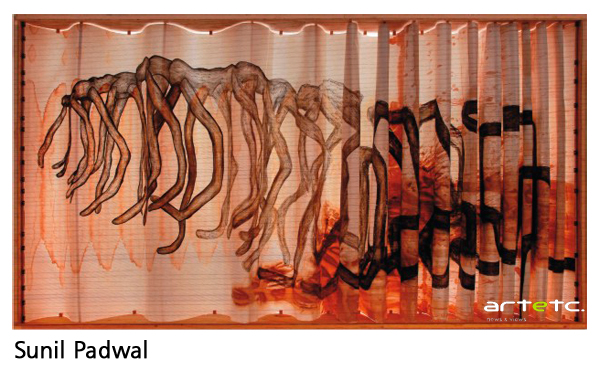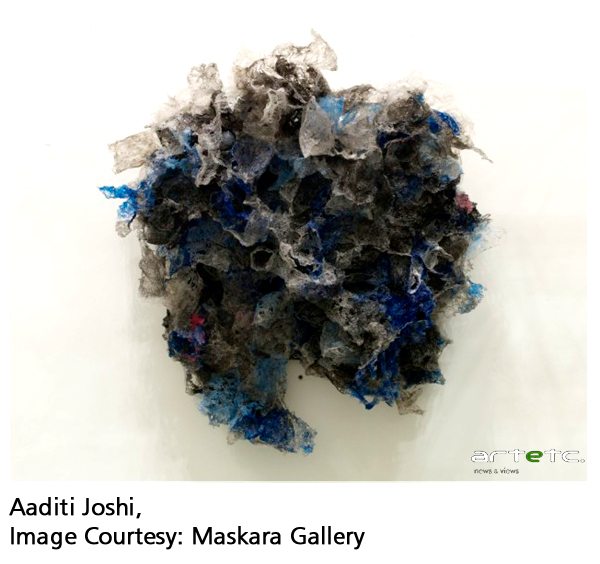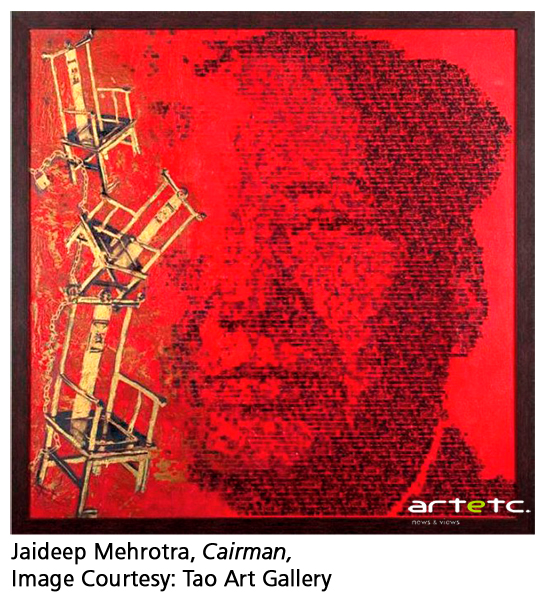- Publisher’s Note
- Editorial
- Progressive Artists Group of Bombay: An Overview
- S. H. Raza: The Modern
- Ara: The Uncommon Commoner
- Art of Francis Newton Souza:A Study in Psycho-Analytical Approach
- M.F. Husain: An Iconoclastic Icon
- Husain’s ‘Zameen’
- Life and Art of Sadanand Bakre
- Hari Ambadas Gade: Relocating the Silent Alleys
- Mysticism Yearning for the Absolute
- Modernist Art from India at Rubin Museum of Art, New York
- Traditional Art from India at the Peabody Essex Museum
- Nandan Mela 2011: A Fair with Flair
- India's First Online Auction of Antiquities
- The Market Masters
- Markets May Plunge and the Rich May Flock To Art
- What Happened and What's Forthcoming
- Random Strokes
- Julian Beever: Morphing Reality With Chalk Asthetics
- Eyes on Life: Reviewing Satish Gujral’s Recent Drawings
- Exploring Intimacy: Postcards of Nandalal Bose
- Irony as Form
- Strange Paradise
- Eyeball Massage: Pipilotti Rist
- René Lalique: A Genius of French Decorative Art
- The Milwaukee Art Museum – Poetry in Motion
- 9 Bäumleingasse
- Art Events Kolkata: November – December 2011
- Art Bengaluru
- Mumbai Art Sighting
- Delhi Dais
- Tacita Dean at Turbine Hall, Tate Modern, London
- Preview: January, 2012 – February, 2012
- In the News: December 2011
ART news & views
Mumbai Art Sighting
Issue No: 24 Month: 1 Year: 2012
The Month That Was
by Jasmine Shah Varma
As 2011 came to a close Mumbai's art galleries packed the merry season with back to back exhibitions. The Bhau Daji Lad Museum built in the 19th century continued its engagement with contemporary art by hosting L N Tallur works. Three of the city's established artists Subhash Awchat, Jaideep Mehrotra and Sunil Padwal had their solo shows. Social concerns were explored in Ravi Agarwal's photography exhibition. German artist Wolfgang Laib's fascinating works on view at two galleries.
Spiritual in the everyday
 Chemould Prescott Road and Galerie Mirchandani + Steinrucke are jointly hosting Wolfgang Laib's fascinating collection titled Passageway until January 13. The 1950 born German artist uses material like rice, ashes, beeswax, pollen and milk in his installations. These things when used to create an art object evoke the impermanence and ephemeral nature of life. His work is informed by Eastern philosophies. Rich yellow of pine tree pollen was sifted through a fabric on to the gallery floor resulting in a pulsating, golden square. This process calls to mind the traditional Tibetan sand mandala technique which is eventually destroyed as part of the ritual. In another of his famed works called Milkstone he has filled up a slim marble square container with milk. You do not see where the liquid and the stone separate; it is a perfect, soft, still, glistening square on the floor. These works are fragile: slight breeze could blow out the pollen, a speck of dirt could tarnish the white of milk and a finger jab could disturb the piles of rice, but when undisturbed they appear perfect, symbols of life's potency.
Chemould Prescott Road and Galerie Mirchandani + Steinrucke are jointly hosting Wolfgang Laib's fascinating collection titled Passageway until January 13. The 1950 born German artist uses material like rice, ashes, beeswax, pollen and milk in his installations. These things when used to create an art object evoke the impermanence and ephemeral nature of life. His work is informed by Eastern philosophies. Rich yellow of pine tree pollen was sifted through a fabric on to the gallery floor resulting in a pulsating, golden square. This process calls to mind the traditional Tibetan sand mandala technique which is eventually destroyed as part of the ritual. In another of his famed works called Milkstone he has filled up a slim marble square container with milk. You do not see where the liquid and the stone separate; it is a perfect, soft, still, glistening square on the floor. These works are fragile: slight breeze could blow out the pollen, a speck of dirt could tarnish the white of milk and a finger jab could disturb the piles of rice, but when undisturbed they appear perfect, symbols of life's potency.
The process is as much part of the work as the final state. There's method to placing conical piles of rice or filling up earthen ware with ashes or dusting the pollen. The tedious process of repeating the action is akin to meditation. Spirituality and the everyday come together in Laib's works.
Unseen pictures
 Delhi-based photographer, artist and activist Ravi Agarwal exhibited a series of pictures shot between 1996 and 2000 in Gujarat along with some newer works at his first solo show in Mumbai at The Guild. Of Value and Labour as the name suggests is about creating value through labour, about wants and commodities. The older series comprises of documentary shots of labourers working at brick kilns, diamond cutting workshops, fabric making factories, labourers loading agricultural products and so on. These rare pictures were shot by following migrant labourers and documenting their lives and work for a collaborative project with Jan Breman, Dutch labour anthropologist who has been researching in India for over 45 years. Their work has been published in a monograph titled Down and Out: Labouring under Global Capitalism.
Delhi-based photographer, artist and activist Ravi Agarwal exhibited a series of pictures shot between 1996 and 2000 in Gujarat along with some newer works at his first solo show in Mumbai at The Guild. Of Value and Labour as the name suggests is about creating value through labour, about wants and commodities. The older series comprises of documentary shots of labourers working at brick kilns, diamond cutting workshops, fabric making factories, labourers loading agricultural products and so on. These rare pictures were shot by following migrant labourers and documenting their lives and work for a collaborative project with Jan Breman, Dutch labour anthropologist who has been researching in India for over 45 years. Their work has been published in a monograph titled Down and Out: Labouring under Global Capitalism.
In a video work he takes the clichéd symbol of capitalism and globalization, empty Coke cans, which are hammered flat to be sold for the tin. He exhibits the idea of how human desires lead to commodities which when utilized and discarded are further commoditized after investing labour to be eventually resold in another form. The exhibition concluded on January 2.
From the diary pages
 Sunil Padwal's Soliloquies: Notes From The Drawing Book opened at Gallery BMB on December 15. Displaying a shift from his popular canvas imagery, this collection made over the last two years comprises line drawings, paper collages and an ink on paper installation. The series of small monochromatic drawings, white pen on black paper, potently depicts the complex nature of the city of Mumbai and man's disturbing relationship to them. Padwal chose to exhibit his drawings and doodling this time to reveal his innermost and heartfelt reactions to the changes and developments taking place in the city while life for the underprivileged has remained the same.
Sunil Padwal's Soliloquies: Notes From The Drawing Book opened at Gallery BMB on December 15. Displaying a shift from his popular canvas imagery, this collection made over the last two years comprises line drawings, paper collages and an ink on paper installation. The series of small monochromatic drawings, white pen on black paper, potently depicts the complex nature of the city of Mumbai and man's disturbing relationship to them. Padwal chose to exhibit his drawings and doodling this time to reveal his innermost and heartfelt reactions to the changes and developments taking place in the city while life for the underprivileged has remained the same.
The collages have more of the abstract quality where bits of torn paper with spontaneously drawn drawings are put together. In another series inspired by an iPhone app designed to provide 'words that make you sound smart', Padwal comments on the influence and the absurdity of technology in our lives. Each work has a word and a definition stenciled in and Padwal's visual take on that. He remarks on the emphasis of marketing and smart packaging that dictates who is heard and seen in today's times.
Compared to the striking palette of his canvasses, where there is a predominant use of red among other shades, this collection appears austere and ever more minimal in spite of the intricate line drawings. The exhibition demonstrates the excellent draughtsman that Padwal has always been. A sense of how fragile and complex our lives are is evoked in these works that are akin to pages from an artist's diary. The exhibition continues till January 27.
The eternal search
Subhash Awchat's solo show titled 4-Shakuntal was held at Jehangir Art Gallery from December 6 to 11. He exhibited a set of works in glittering gold and black hues that remarked on mankind's search for eternal truth. On visiting numerous ancient temples in India and religious monuments across the world Awchat observed how the exteriors of these edifices are always ornamented and adorned with riches but once inside, they are austere. Awchat's gold canvases are metaphorical in that vein of thought, the outside glitters while the truth lies in the dark corners beyond the facade. The other set of works were large head portraits of ascetics. In these he has tried to capture ghostly vacant expressions of unknown people in search of something undefined. With the power of dramatic colour schemes with a dominant use of black, Awchat created moving imagery.
Plastic art

Gallery Maskara is hosting young artist Aaditi Joshi's new works until January 29th. The Mumbai based artist's preoccupation with the virtues of omnipresent plastic bags has turned into large scale installations in this show. Ordinary plastic bags are burned meticulously, stiffened and then clustered together methodically to create textured and coloured, sculptural works. The ubiquitous material, useful one moment and rubbish the second is converted into an object of art after a creative process. It becomes an object of marvel the way Joshi creates large, overhanging structures out of it. Through her artistic process the artist contemplates on human life and its endless plastic needs. These works and the material used are most relevant to the times we live in.
Glorifying the mundane

Gallery Beyond has on exhibit new works by Prajakta Palav Aher and Rajan Krishnan in a show titled Palimpsest until January 14. Palav's works have always carried an element of surprise. The works pop out of the gallery space inconspicuously and in unexpected ways and places. She is preoccupied with the ordinary, lived-with objects that emerge from the gallery walls in the 'Tiny Corners II' series. The canvases are embedded in the gallery's white walls and colourful household objects that fill up our days emerge from the illusions of gaps she creates: clothes, toys, bottles and cartons peep out of crevices and slits. These works are installed unconventionally; above or below eye level or in corners. In Butterfly Butterfly Flying Flying named after the song Palav's child's sings, we see the gallery's floor tiles replicated ditto in paint on canvas. The unseen becomes seen. The overlooked and the taken-for-granted are potent storytellers and receptacles of time and history in her work.
In Other Shows
 Jaideep Mehrotra's solo show took place at Tao Art Gallery from December 1 to 15. He exhibited a new body of work in Metonymical Subtext after a gap of four years. Mehrotra commented on the age of technology and information which has transformed our lifestyles and priorities. He combined the act of painting with digitally printed overlays, creating layers of narrative and engaging visual imagery. This body of work was an investigation in how perception and meaning are altered by shifting traditional parameters.
Jaideep Mehrotra's solo show took place at Tao Art Gallery from December 1 to 15. He exhibited a new body of work in Metonymical Subtext after a gap of four years. Mehrotra commented on the age of technology and information which has transformed our lifestyles and priorities. He combined the act of painting with digitally printed overlays, creating layers of narrative and engaging visual imagery. This body of work was an investigation in how perception and meaning are altered by shifting traditional parameters.
The Bhau Daji Lad Museum opened yet another exhibition of contemporary art in its premises under the curatorial endeavor by Tasmeen Mehta. This time interactive and sculptural works by LN Tallur are on view till February 4. Quintessential presents irreverent and humorous works that pose serious queries about old traditions and the modern world. Works like ATM (Anger Therapy Machine) engages the viewer who is encouraged to pull the hand-swayed fabric fan to manage anger. In Chromatophobia, a log of wood is held between ancient-looking bronze figurines. The viewer is asked to hammer a currency coin into the wood while making a wish. Hundred of coins have been embedded so far! Tallur makes witty commentary on desires, values, traditions, and the contemporary world with his creations. The fact that the exhibition is hosted in a museum built in the 19th century displaying traditionally made artifacts provides an apt context to Tallur works and intentions.